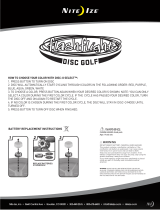
Safety Information
2 - English
Please read this guide
Please read this owner’s guide carefully and save it for future reference.
The lightning ash with arrowhead symbol within an equilateral triangle alerts the user to the presence of
uninsulated, dangerous voltage within the system enclosure that may be of sufcient magnitude to
constitute a risk of electric shock.
The exclamation point within an equilateral triangle, as marked on the system, is intended to alert the user
to the presence of important operating and maintenance instructions in this owner’s guide.
WARNINGS:
• To reduce the risk of re or electrical shock, do not expose the product to rain or moisture.
• Do not expose this apparatus to dripping or splashing, and do not place objects lled with liquids, such
as vases, on or near the apparatus. As with any electronic products, use care not to spill liquids into any
part of the system. Liquids can cause a failure and/or a re hazard.
• Solo 10 remote:
Warning: Do not ingest battery, chemical burn hazard.
The remote control supplied with this product contains a coin/button cell battery. If the coin/button cell
battery is swallowed it can cause severe internal burns in just two hours and can lead to death. Keep
new and used batteries away from children. If the battery compartment does not close securely, stop
using the product and keep it away from children. If you think the battery may have been swallowed
or placed inside any part of the body, seek immediate medical attention. The coin/button cell battery
may explode or cause a re or chemical burn if incorrectly replaced or mishandled. Do not recharge,
disassemble, heat above 212°F (100°C) or incinerate. Replace only with an agency approved (ex. UL)
CR2032 or DL2032 3-volt lithium battery. Dispose of used batteries promptly.
• Solo 15 remote: Do not dismantle, open or shred battery pack or cells. Do not expose batteries or
a battery pack to heat or re. Avoid storage in direct sunlight. Do not short-circuit battery. Do not store
batteries carelessly in a box or drawer where they may short-circuit each other or be short-circuited by
other metal objects. Do not remove a battery from its original packaging until required for use. Do not
subject batteries to mechanical shock. In the event of a battery leaking, do not allow the liquid to come
in contact with the skin or eyes. If contact has been made, wash the affected area with copious amounts
of water and seek medical advice. Observe the plus (+) and minus (-) marks on the battery and equip-
ment and ensure correct use. Do not use any battery pack or cell which is not designed for use with the
product. Keep batteries out of the reach of children. Seek medical advice immediately if a battery has
been swallowed. Always purchase the correct battery for the equipment. Keep batteries clean and dry.
Wipe the battery terminals with a clean dry cloth if they become dirty. Use the battery only in the applica-
tion for which it was intended. When possible, remove the battery from the equipment when not in use.
Replace only with AA (IEC LR06) alkaline batteries.
• Do not place any naked ame sources, such as lighted candles, on or near the apparatus.
• Never place the equipment in an unstable location. The equipment may fall, causing serious personal
injury or death. Many injuries, particularly to children, can be avoided by taking simple precautions
such as:
- Using cabinets or stands recommended by the manufacturer of the equipment.
- Only using furniture that can safely support the equipment.
- Ensuring the equipment is not overhanging the edge of the supporting furniture.
- Not placing the equipment on tall furniture (for example, cupboards or bookcases) without anchoring
both the furniture and the equipment to a suitable support.
- Not standing the equipment on cloth or other materials placed between the equipment and supporting
furniture.
- Educating children about the dangers of climbing on furniture to reach the equipment or its controls.
• If you doubt your ability to safely mount your television or set up this product, contact a professional
installer for help.
• Do not allow children to push, pull, or climb on an A/V monitor. This may cause it to tip over, possibly
resulting in personal injury or death. For added safety and stability, be sure to secure the monitor using
a suitable anti-tip device.




















